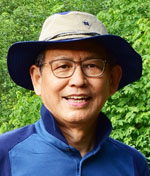Prof. Jae-Sang Hong
Prof. Jae-Sang Hong --- Keynote speaker

・Professor Emeritus of Marine Benthic Ecology
Department of Ocean Sciences, Inha University, Korea
・CEO of Korean Institute of Coastal Ecology
・Member of the Korean Society of Oceanography, Korea
(Former Vice President)
・Committee to Review the Policies and National Projects of
the Ministry of Oceans & Fisheries, Korea (2015 – Present)
・Committee to Review the National Sand Extraction Projects
(2013 – Present)
・Director of the Zoobank of the Korean Marine Annelids
(2014 – Present)
Major field: Benthos Biology and Ecology
Main Studies
・Estuarine and nearshore marine benthic ecosystem structure and dynamics,
focusing on the tidal flats
・Coastal wetland restoration ecology; functional assessment of restored,
created and enhanced wetlands
・Natural history and diversity of benthic macro-invertebrates in Korean coastal waters
・Coastal ecosystem management with emphasis on functional roles
of the tidal flat ecosystem
Abstract of Keynote Speech
Tidal Flats of Korea: biodiversity and distribution pattern of macro-benthic animals
Coastal wetlands are especially well known for providing habitats food, and protection to many different species of animals (e.g. fish, birds, mammals, and invertebrates), and also for their valuable role as nurseries for various species of fish and shellfish, including endangered and commercially important species. Therefore, they are recognized as a vital ecosystem for human well-being.
According to historical topographic maps of the Yellow Sea, tidal flats occupied 1.12 million ha in the mid-1950s, equaling potential net loss of up to 65% over 50 years suggesting that up to two-thirds of the tidal flats have since vanished (Murray et al. 2014). In the case of Korean tidal flats, they indicated that, of the 350,331 ha present in the 1950s, only 120,472 ha remained six decades later in the 2000s, equating to a net loss of 65.6% at a mean rate of –2.4% yr–1. However, the Korea Ministry of Oceans and Fisheries recently reported that the area of South Korean tidal flats was 2,487.2 km2 in 2013 based on the coastline survey and electronic navigation chart, and 22.4% (about 716 km2) was lost between 1987 and 2013 due to the large scale reclamation projects of Saemangeum and Sihwa districts on the western coast.
Due to the overwhelming value of biodiversity as an indication of environment health and for the functioning of ecosystems, a nationwide survey of the macro-benthic invertebrate assemblages was done according to Korea wetland conservation law at eight regional tidal mud and sand flats along the Korean coasts and summarized here. Sampling locations were distributed across nearly the entire coast of south Korean peninsula from Incheon in the west coast to Gangwon in the east coast through Nakdong River Estuary including Jeju Island to the south. Surveys were conducted from 2008 to 2016 at high tide by boat, but at low tide in the East coast to 1) determine the taxonomic composition of the fauna, 2) to obtain measures of macro-benthic standing crop expressed in terms of density and biomass, and 3) to map the general features of macro-benthic distribution. The samples were collected using a 0.05m2 grab with two replicates, sieved on a 1 mm opening mesh, enumerated for the abundance, and weighed for the biomass.
As a result, 837 macro-invertebrate species were found from 1,389 sampling stations in total during the study period. In terms of biodiversity, these data showed three most dominant zoological groups were the crustaceans with 310 species (37%), followed by polychaetes with 241 species (28.8%), and mollusks with 203 species (24.3%) respectively. Overall, the sediment composition determined macro-benthic biodiversity so that species richness peaked in the southern sea where the bottom sediment tended to be more heterogeneous from mud (M) to muddy sandy gravel (msG), but the lowest diversity was recorded in the eastern coast where it was from gravelly sand (gS) to gravel (G). The intermediate species richness occurred in the west coast due to somewhat homogeneous sediment types between silt (Z) and silty sand (zS) even though the areal extent of tidal flats was largest.
